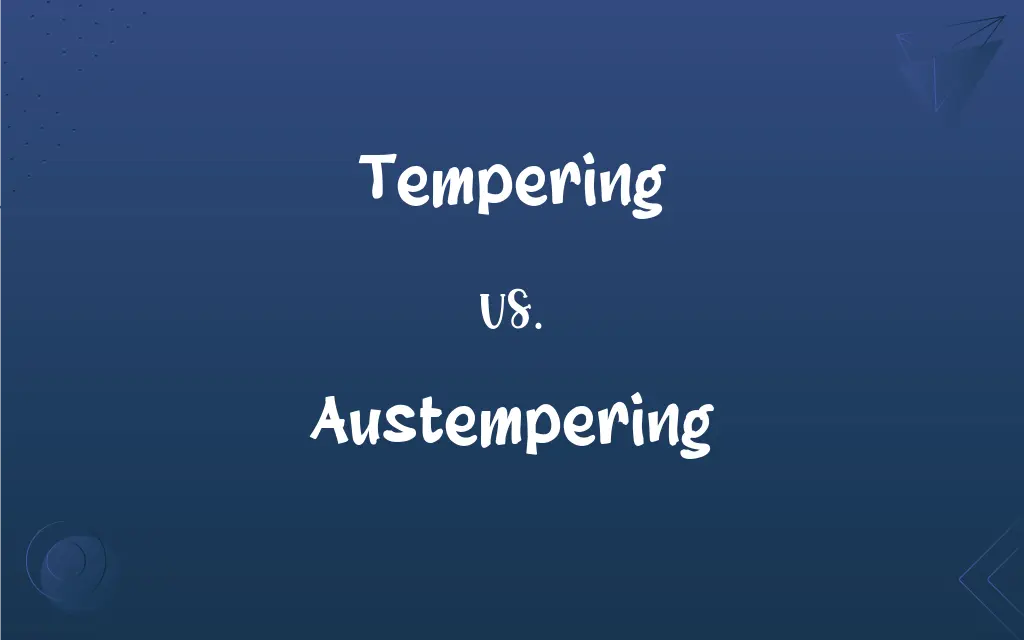Tempering vs. Austempering: What's the Difference?
Edited by Aimie Carlson || By Janet White || Published on February 21, 2024
Tempering involves heating hardened steel below its critical point to reduce brittleness, while austempering is a heat treatment that involves quenching steel from the austenitizing temperature into a bath maintained at an intermediate temperature.

Key Differences
Tempering is a heat treatment process applied after quenching, where the steel is reheated to a temperature below its critical point. This process aims to adjust the hardness and brittleness of the steel. Austempering is also a post-quenching process, but it involves holding the steel at a constant temperature above the martensite start temperature.
The primary goal of tempering is to improve the ductility and toughness of the steel while maintaining a degree of hardness. Austempering, on the other hand, produces bainite, a microstructure that offers a unique combination of strength and ductility.
Tempering typically results in a trade-off between hardness and toughness; as the tempering temperature increases, hardness decreases but toughness improves. In austempering, both hardness and toughness can be optimized without as significant a trade-off.
The microstructure resulting from tempering is tempered martensite, which is less brittle than untempered martensite. Austempering leads to the formation of bainite, which has a different microstructure and properties compared to tempered martensite.
Tempering is widely used for a variety of steel grades and applications, offering a good balance of mechanical properties. Austempering is more specialized, often used in applications requiring higher strength and toughness, like certain automotive parts or tools.
ADVERTISEMENT
Comparison Chart
Process
Reheating after quenching below critical point
Quenching from austenitizing to intermediate temp
Goal
Improve ductility and toughness
Produce bainite for strength and ductility
Microstructure
Produces tempered martensite
Results in bainite formation
Hardness-Toughness Trade-off
Trade-off between hardness and toughness
Optimizes both hardness and toughness
Typical Applications
Varied, general steel applications
Specialized, high strength/toughness needs
ADVERTISEMENT
Tempering and Austempering Definitions
Tempering
Process of reheating quenched steel to reduce brittleness.
The blade underwent tempering to achieve the desired balance of hardness and flexibility.
Austempering
A process to create a fine-grained bainitic structure.
The austempered parts exhibited exceptional fatigue resistance.
Tempering
A heat treatment to increase the toughness of iron-based alloys.
Tempering was used to enhance the toughness of the steel components.
Austempering
Heat treatment for achieving optimal mechanical properties.
Austempering provided the steel with an excellent combination of strength and ductility.
Tempering
A method to adjust the properties of hardened steel.
Tempering allowed for fine-tuning the mechanical properties of the gears.
Austempering
Technique to enhance steel performance for specific applications.
Austempering was used for critical components in high-stress environments.
Tempering
Heating steel to alleviate stresses from hardening.
The tempering process was crucial for relieving internal stresses in the welded structure.
Austempering
Quenching steel to an intermediate temperature to improve toughness.
The gear's austempering process resulted in superior strength and durability.
Tempering
Enhancing material properties through controlled heating.
The tempered glass showed improved safety features.
Austempering
A heat treatment that forms bainite in steel.
Austempering was chosen to produce a tougher and more wear-resistant steel.
Tempering
To modify by the addition of a moderating element; moderate
"temper its doctrinaire logic with a little practical wisdom" (Robert H. Jackson).
Austempering
Present participle of austemper
Tempering
To bring to a desired consistency, texture, hardness, or other physical condition by blending, admixing, or kneading
Temper clay.
Paints that had been tempered with oil.
FAQs
Is austempering suitable for all steel types?
No, austempering is best suited for certain alloys that can form bainite.
What microstructure is formed by austempering?
Austempering forms bainite, a fine-grained microstructure.
Can tempering affect the hardness of steel?
Yes, tempering generally reduces the hardness slightly while increasing toughness.
How does the tempering temperature affect steel properties?
Higher tempering temperatures typically decrease hardness but increase toughness.
What is the main purpose of tempering steel?
To increase the toughness and reduce the brittleness of hardened steel.
Can austempering improve wear resistance?
Yes, austempering often improves wear resistance due to the formation of bainite.
Is tempered steel less hard than quenched steel?
Yes, tempered steel is generally less hard but more tough compared to quenched steel.
What advantages does austempering offer over traditional quenching and tempering?
Austempering can provide a better combination of strength and ductility with less risk of distortion.
Is austempering more expensive than traditional tempering?
Generally, austempering can be more expensive due to its specialized process and equipment requirements.
Does tempering involve rapid cooling?
No, tempering involves controlled heating and slow cooling.
What are the typical applications of austempered steel?
Austempered steel is often used in automotive parts, gears, and wear-resistant applications.
How long does the tempering process take?
The duration varies but can range from less than an hour to several hours, depending on the steel type and desired properties.
Can tempering eliminate all stresses in hardened steel?
Tempering significantly reduces internal stresses but may not eliminate them entirely.
Does austempering require a controlled atmosphere?
Yes, austempering often requires a controlled atmosphere to prevent oxidation and achieve the desired properties.
Why is tempering an essential step after quenching?
To alleviate the extreme hardness and brittleness caused by quenching.
Can tempering be repeated multiple times?
Yes, multiple tempering cycles can be used to achieve specific properties.
Can austempering reduce the risk of cracking in steel?
Yes, due to its less severe quenching process, austempering can reduce the likelihood of cracking.
What is the typical temperature range for austempering?
Austempering usually occurs at temperatures between 150°C and 400°C.
How does tempering affect the color of steel?
Tempering can cause color changes on the steel surface due to oxide formation at different temperatures.
Is austempering suitable for high-carbon steels?
Yes, high-carbon steels can benefit from austempering, especially for improved toughness.
About Author
Written by
Janet WhiteJanet White has been an esteemed writer and blogger for Difference Wiki. Holding a Master's degree in Science and Medical Journalism from the prestigious Boston University, she has consistently demonstrated her expertise and passion for her field. When she's not immersed in her work, Janet relishes her time exercising, delving into a good book, and cherishing moments with friends and family.
Edited by
Aimie CarlsonAimie Carlson, holding a master's degree in English literature, is a fervent English language enthusiast. She lends her writing talents to Difference Wiki, a prominent website that specializes in comparisons, offering readers insightful analyses that both captivate and inform.







































































